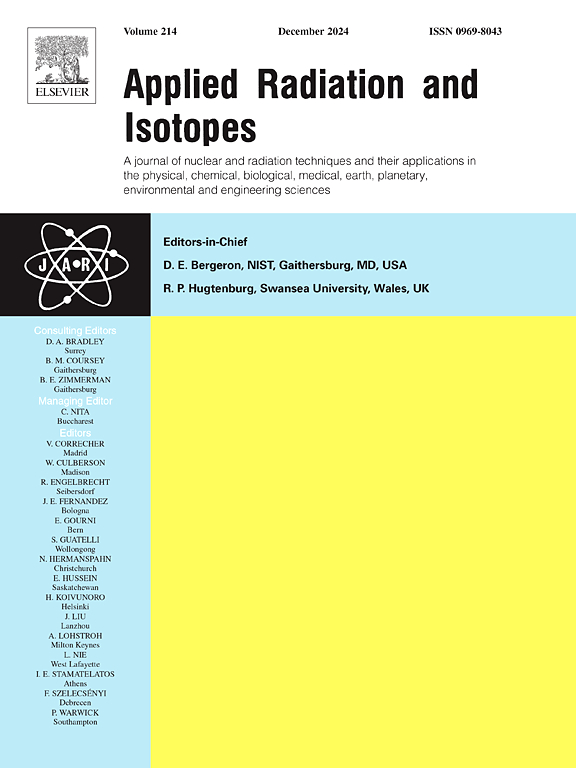Sorption behavior of 137Cs and 60Co onto raw and cellulose-modified Greek bentonite
IF 1.6
3区 工程技术
Q3 CHEMISTRY, INORGANIC & NUCLEAR
引用次数: 0
Abstract
Sorption properties of Greek bentonite from Kimolos in raw form and after cellulose-radiation modification were investigated for removal of cesium and cobalt from aqueous solutions. The sorption experiments were undertaken under different metal concentrations, without and with interfering ions, in single as well as in binary systems and the aqueous phase was analyzed through gamma ray-spectrometry using 137Cs and 60Co as tracers. Kinetic experiments revealed an ion exchange process. The structural and physicochemical changes after modification and metal sorption were examined through X-ray diffraction (XRD), Fourier transformed infrared spectroscopy (FTIR), scanning electron microscopy with energy dispersive X-ray spectroscopy (SEM-EDS), whereas the pH of point of zero charge (pHpzc) and cation exchange capacity (CEC) were also determined. Sorption isotherms were reproduced through non-linear mathematical models, like the modified competitive Langmuir (MCL) and extended Freundlich (EF) models and their prediction accuracy was statistically tested through paired t-test at the 95 % confidence level. The results showed that both materials exhibited significant capacities (117 and 90 mg g−1 the raw and modified bentonite for Cs, and 98 and 78 mg g−1 for Co respectively). Both ions were found to have antagonistic behaviour in the binary system.
原料和纤维素改性希腊膨润土对137Cs和60Co的吸附行为
为了从水溶液中去除铯和钴,对希腊基莫洛斯膨润土的原始形态和纤维素辐射改性后的吸附特性进行了研究。吸附实验是在不同的金属浓度、无干扰离子和有干扰离子、单一系统和二元系统中进行的,并使用 137Cs 和 60Co 作为示踪剂,通过伽马射线光谱法对水相进行了分析。动力学实验揭示了一个离子交换过程。通过 X 射线衍射(XRD)、傅立叶变换红外光谱(FTIR)、扫描电子显微镜与能量色散 X 射线光谱(SEM-EDS)对改性和金属吸附后的结构和物理化学变化进行了研究,同时还测定了零电荷点的 pH 值(pHpzc)和阳离子交换容量(CEC)。吸附等温线是通过非线性数学模型(如修正的竞争性朗缪尔(MCL)模型和扩展的弗赖德利希(EF)模型)再现的,其预测准确性通过 95 % 置信度的配对 t 检验进行了统计检验。结果表明,两种材料都表现出了显著的吸附能力(原膨润土和改性膨润土对铯的吸附能力分别为 117 毫克/克-1 和 90 毫克/克-1,对钴的吸附能力分别为 98 毫克/克-1 和 78 毫克/克-1)。发现这两种离子在二元体系中具有拮抗作用。
本文章由计算机程序翻译,如有差异,请以英文原文为准。
求助全文
约1分钟内获得全文
求助全文
来源期刊

Applied Radiation and Isotopes
工程技术-核科学技术
CiteScore
3.00
自引率
12.50%
发文量
406
审稿时长
13.5 months
期刊介绍:
Applied Radiation and Isotopes provides a high quality medium for the publication of substantial, original and scientific and technological papers on the development and peaceful application of nuclear, radiation and radionuclide techniques in chemistry, physics, biochemistry, biology, medicine, security, engineering and in the earth, planetary and environmental sciences, all including dosimetry. Nuclear techniques are defined in the broadest sense and both experimental and theoretical papers are welcome. They include the development and use of α- and β-particles, X-rays and γ-rays, neutrons and other nuclear particles and radiations from all sources, including radionuclides, synchrotron sources, cyclotrons and reactors and from the natural environment.
The journal aims to publish papers with significance to an international audience, containing substantial novelty and scientific impact. The Editors reserve the rights to reject, with or without external review, papers that do not meet these criteria.
Papers dealing with radiation processing, i.e., where radiation is used to bring about a biological, chemical or physical change in a material, should be directed to our sister journal Radiation Physics and Chemistry.
 求助内容:
求助内容: 应助结果提醒方式:
应助结果提醒方式:


